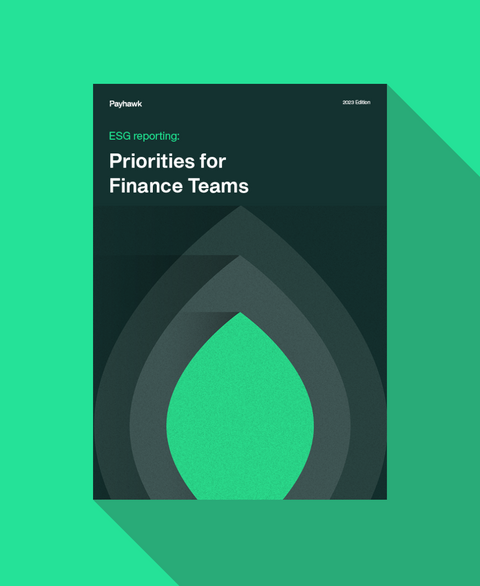
The sometimes ‘hidden’ benefits of ESG reporting



Demands for sustainability reach all corners of an organisation, including finance. In this article, we interviewed three ESG or finance leaders to outline the role of carbon accounting within finance management, challenges related to ESG reporting, and reasons and ways to improve the accuracy of measuring the financial carbon footprint.
By submitting this form, you agree to receive emails about our products and services per our Privacy Policy.
Asset managers, VC investors, b2b customers, and consumers are all increasingly considering ESG (Environmental, Social, and Governance) factors when making decisions. And in January 2023, the European Union adopted the Corporate Sustainability Reporting Directive (CSRD), making it mandatory for your business to submit sustainability reports together with yearly financial statements to offer more clarity over your environmental impact.
ESG reporting ebook: Discover the priorities for finance teams

Why should you care about ESG reporting?
As the name suggests, ESG criteria will help your company evaluate its environmental, social, and governance structure, procedures, and footprint. Depending on your size and location, measuring your operations is mandatory and offers clarity for both your business and external stakeholders.
The reporting mandates that you measure certain factors, like CO2 and Scope 3 emissions (associated with suppliers). It lets you see the impact of your operations so that you can make more environmentally conscious decisions, kickstart offsetting initiatives, and more.
Outside of your own strategic business decisions, the purpose of ESG is to provide stakeholders and investors with an easily digestible framework that outlines your company’s impact on society and the environment, aligned with its corporate governance practices. ESG has become so important that an entire niche of investing is essentially dedicated to it.
Benefit 1: Getting more eco-conscious investors onboard
The first benefit is attracting more investors by addressing environmental, social, and governance factors. Ethical investors focused on an ESG-led investment strategy will be more interested in your company if you prove that you agree with its principles.
Do you think it doesn't matter to you or your industry? That may be true — for now. However, ESG reporting is only likely to become more prominent in the future, especially considering its importance to younger generations. Thus, those companies that invest in the transparency and accountability associated with ESG now will benefit the most going forward.
CEO of carbon accounting and removal business, Lune, Erik Stadigh, says:
Specific businesses must adjust to new regulations and challenges. Even if they don't currently fall under these directives, it still makes sense to prepare. Beyond regulatory compliance businesses, carbon emission monitoring will help you take a good first step in prioritising sustainability in your company. It can let you identify the low-hanging fruit and inform an action plan of the next steps.
Benefit 2: Understanding your supply chain, and how to improve it
One of the other big benefits of ESG reporting is improved supply chain management and supplier insights.
ESG reporting involves difficult-to-measure Scope 3 emissions (associated with your supply chain). Although challenging, at Payhawk, our complete spend management platform includes features like Payhawk Green, which lets companies track their CO2 spend, including Scope 3 emissions.
Erik at Lune, says:
Scope 3 emissions are undoubtedly more complicated than scopes 1 and 2. However, dealing with these emissions is vital as they can help you collaborate with suppliers and peers to create an even bigger, more positive impact. If you're aiming for net zero, then minimising these emissions is essential to your journey.
By accurately measuring your Scope 3 emissions, you can better understand your operations and ultimately improve your collaboration with suppliers.
Benefit 3: Reducing operational carbon footprint
The third (and most important) benefit of ESG reporting involves reducing the carbon footprint from your operations.
Here are a few tried and tested examples:
For example, you could work more closely with suppliers to improve energy consumption or reduce greenhouse gas emissions as part of your ESG transition. This approach could have the knock-on benefit of reducing the cost of production or the acquisition of vital materials and reducing your environmental footprint.
Another (non-Scope 3) example could involve introducing specific tax-free schemes like cycle to work (in the UK), which could lead to lower CO2 emissions by removing cars from the road and even save your business financially where you might have been subsidising mileage, car parking, and more.
Understanding how ESG reports connect to company operations
Ultimately, examining ESG-related topics can help your business identify opportunities for improvement, pinpointing what is and isn't working within your operations. Creating effective ESG reports is only possible once you've gathered enough data about your workforce, supply chain workflows, internal operations, financial controls, and infrastructure, which all play a significant part in achieving your ESG goals.
By accurately recording your carbon footprint and compiling your ESG reports, you can get insight into areas ripe for improvement. This laser focus can help you make better choices about producing and using energy, leading to increased efficiency.
Nailing your ESG reporting and strategy isn't just about the environment; it offers many ways to improve your business. From refining waste policies to innovating new products and expanding into new areas, it can open doors to more growth, boost productivity, and streamline operations, leading to long-term benefits that align with your company's goals.
Achieving stakeholder buy-in for ESG report action items
So far, so good. But what about investors who are concerned about the costs involved in altering operations in accordance with ESG principles?
Here, it comes down to communication. If you communicate with stakeholders effectively, you can achieve their buy-in with this process. The key here is to make it clear that ESG reports aim to INCREASE your operational efficiency on the path to becoming a more sustainable business rather than take away from your production in favour of the external environment.
Investors are genuinely concerned about whether companies have long-term sustainability and whether they face any risks related to the ESG legislation, so it pays to be prepared. Make sure you can demonstrate that your CSRD strategy involves actions that support the business and remove risk rather than disrupting it.
Creating an ESG-led culture from the top of an organisation is critical in achieving stakeholder buy-in. Top-level management must be demonstrably active in ESG initiatives. Once this ethos is communicated, you can use many tools across training and human capital, both on a macro and micro level.
Adapting a four-pronged approach when creating ESG reports
A four-pronged approach involves to ESG report formation involves:
- Creating thorough operational research that aims to identify areas for improvements organisation-wide
- Establishing a clear set of objectives for each one of your company sectors
- Embedding these goals throughout your organisation, making them part of your core KPIs
- Clearly communicating a message of sustainability as part of your overarching ESG policy
It's also important to make this dialogue two-way. Encourage employees to ask questions, share concerns, and communicate ideas and aspirations. Collectively, these things help change the dialogue around ESG, and involving your employees can go a long way toward making them an active part of creating change.
Finally, set policies and strategies—and communicate them—to ensure that everyone shares responsibility and knows what's expected of them. Every employee plays a part in aligning the company with ESG principles, affecting decisions, big and small, across all levels of the organisation.
Exploring the untapped benefits of ESG reporting: Your next steps
In a nutshell, by focusing on ESG and getting your reporting right, your business can identify areas for improvement, streamline operations, and foster a culture of sustainability.
Learn more about Payhawk Green and how we can help your business track CO2 spending. If you're ready to discuss this further, book a demo today.
Trish Toovey works across the UK and US markets to craft content at Payhawk. Covering anything from ad copy to video scripting, Trish leans on a super varied background in copy and content creation for the finance, fashion, and travel industries.
Related Articles


How to leverage supplier engagement for better Scope 3 emissions reporting

